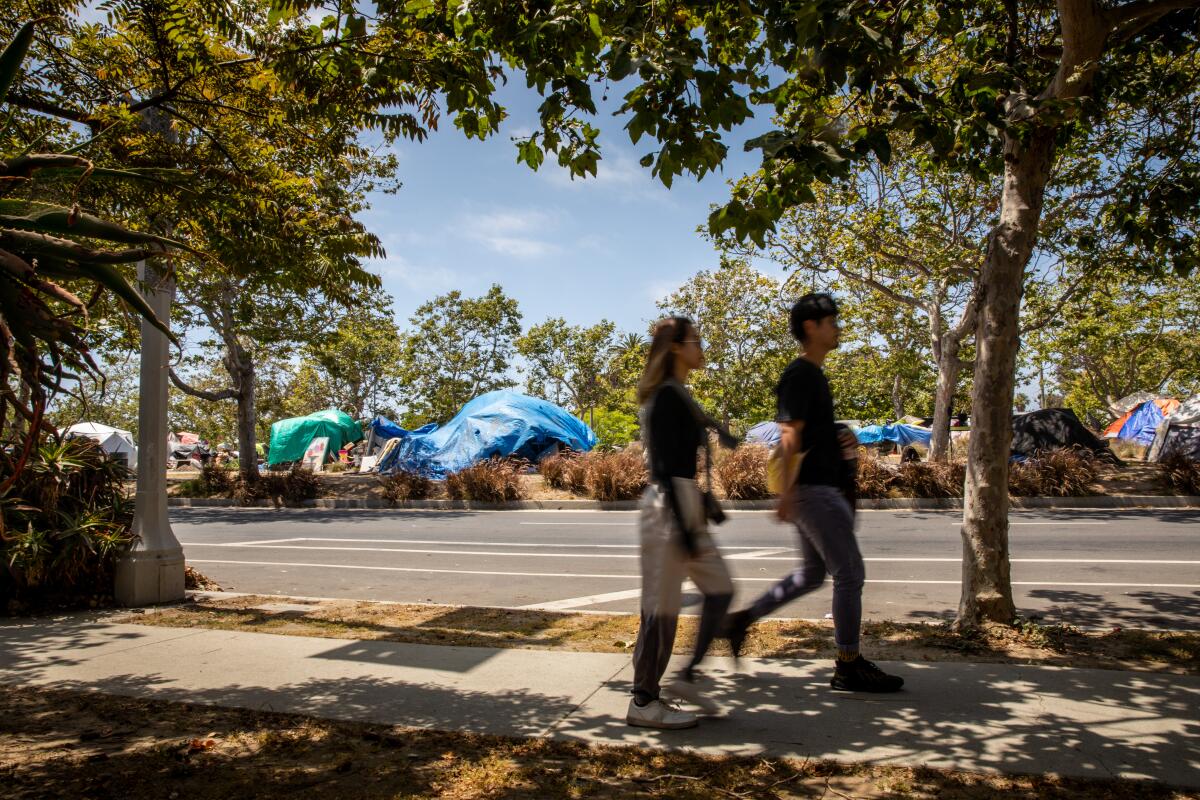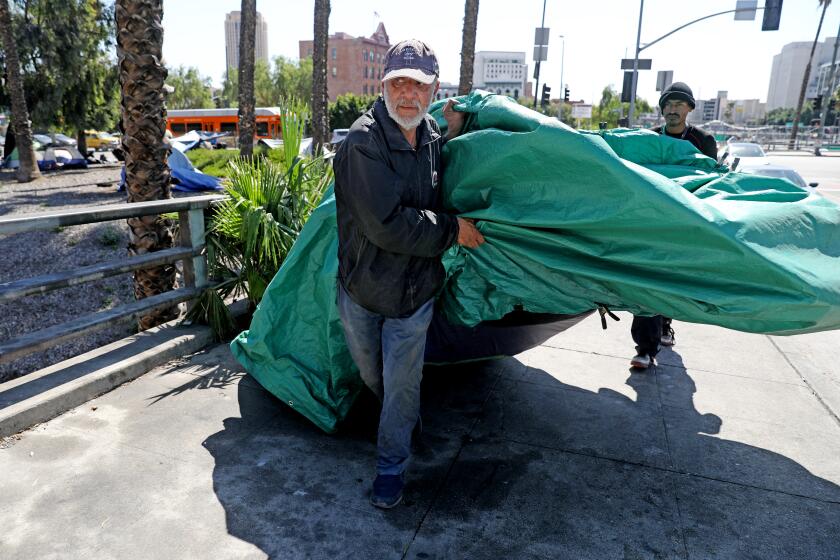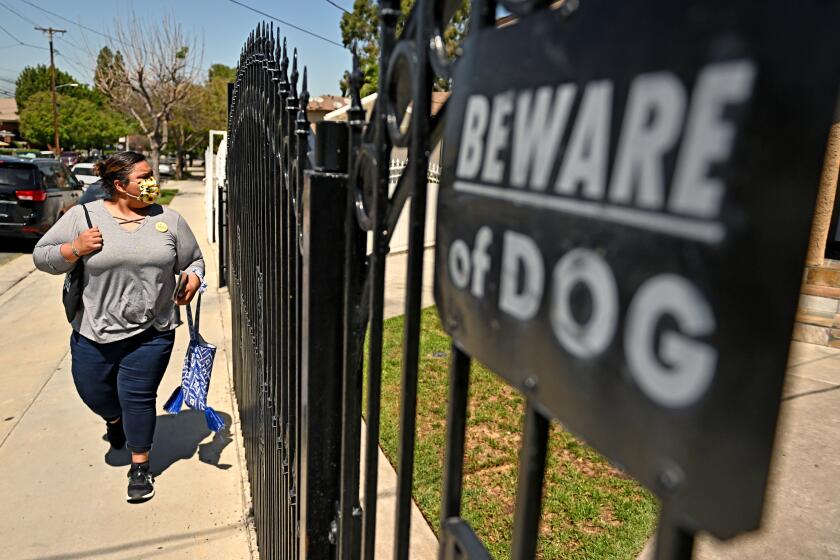L.A. City Council seeks to ban homeless encampments near every school, daycare center

The Los Angeles City Council on Tuesday instructed its lawyers to draft a major change to the city’s anticamping ordinance, barring homeless encampments within 500 feet of schools and daycare centers.
The council voted 13-2 to draft legal language that would expand its anticamping law to cover hundreds, possibly thousands, of educational facilities.
Councilmembers made the decision after hearing from parents of children at Virgil Middle School and from Alberto M. Carvalho, superintendent of the Los Angeles Unified School District, about incidents involving homeless people immediately outside campuses.
Carvalho, appearing at the council meeting in person, urged members to approve the measure, saying students have been witnessing behavior that threatens to cause trauma and to harm cognitive development.
“I’ve seen elementary schools with conditions that none of us as parents would find acceptable for our children: individuals with mental illness, some of them absolutely unclothed, shouting profanities to the listening ear of children,” he said.
Get the lowdown on L.A. politics
Sign up for our L.A. City Hall newsletter to get weekly insights, scoops and analysis.
You may occasionally receive promotional content from the Los Angeles Times.
Councilmembers Mike Bonin and Nithya Raman cast the two opposing votes.
Bonin, who represents coastal neighborhoods, said the proposal’s sudden appearance on the council floor violated the provisions of the state’s public meeting law. He also said the plan, if enacted, would simply push encampments to nearby locations.
“So instead of [an encampment] being in front of the school, it’s going to be a block from the school, or two blocks from the school,” he said.
The proposal was unveiled and approved one week before Tuesday’s election, as several council incumbents are locked in competitive races. In many of those contests, homelessness and public safety have dominated the debate.
Councilmembers Bob Blumenfield, Gil Cedillo, Mitch O’Farrell, Curren Price and Monica Rodriguez are running for reelection; Councilman Kevin de León is a candidate for mayor; and Councilman Paul Koretz is campaigning for city controller.
All voted in favor of the new measure.
Council President Nury Martinez, who spearheaded the measure, said she had been contacted by Carvalho about problems with encampments outside schools across the city.
Cedillo said he had heard from elementary schools in Highland Park and Mount Washington.
“This is what they want,” he said. “This is what the community ... insists and demands.”
Advocates for the homeless objected to both the substance of the measure and the speed with which the council proposed and approved it.
The measure would represent a dramatic shift in the city’s approach to homeless encampments, rewriting a key aspect of an ordinance that was finalized only last summer following weeks of contentious debate.
The existing anticamping ordinance allows the council to prohibit camping on sidewalks around parks, libraries and schools. However, enforcement cannot occur until the council has reviewed a specific location and voted to give the go-ahead to clear it.
Enforcement of Los Angeles’ revised anti-camping law rolls out in slow and uneven steps.
When the law was proposed, critics argued that it would punish people for living on the streets. Councilmembers, in turn, promised that any enforcement would be accompanied by “street engagement teams”: social workers, mental health specialists and others who would offer the unhoused shelter and services.
The Times recently found that the ordinance has been unevenly enforced and that the rollout has been hampered by a lack of outreach teams to connect homeless people with services.
Tuesday’s measure was adopted without review from the council’s Homelessness and Poverty Committee, which is headed by De León. If the council approves the changes to its anticamping law, every school and daycare center could become a subject of immediate enforcement, without the lengthier review process.
Pete White, who runs the antipoverty organization Los Angeles Community Action Network, said he fears the changes will punish those who are living on the street, pushing them even further out of sight. Tuesday’s move by the council, so soon before an election, sends a clear message, he said.
“This signals to an increasingly agitated electorate that there is a response coming from those sitting behind the horseshoe,” he said.
He added that this is an instance of elected officials again focusing on banning people from certain locations and not on creating more housing and services for a vulnerable population.
In recent months, tents have remained at many of the city’s no-encampment areas, with outreach workers struggling to persuade people to move voluntarily. So far, the Los Angeles Police Department has issued tickets sparingly.
Councilman Gil Cedillo faces a major challenge from activist Eunisses Hernandez, in a race focused on housing prices and calls to eliminate police.
Eunisses Hernandez, who is looking to unseat Cedillo in next week’s election, called the council’s action “horrific.”
“Banning encampments from specific locations only pushes people around and does nothing to get folks off the streets into housing,” she said. “There is only one thing that effectively reduces the presence of encampments, and that is long-term housing and care.”
Hugo Soto-Martinez, a labor organizer running against O’Farrell, said he understands parents’ concerns, but the proposal would waste millions while “moving encampments from block to block.”
Kate Pynoos, a former Bonin aide running against O’Farrell, also criticized the measure. She said O’Farrell and his colleagues “cynically cloaked this back-room motion in terms of ‘supporting the youth.’ ”
“What motivates O’Farrell is simply pushing the unhoused out of sight, rather than actually solving this crisis by providing them with permanent housing,” she said.
O’Farrell, before casting his vote, offered a different take, saying his office has been making steady progress on bringing people “under a roof,” in both temporary facilities and permanent housing.
“We are standing up more housing solutions than ever before across this city,” he said.
More to Read
Sign up for Essential California
The most important California stories and recommendations in your inbox every morning.
You may occasionally receive promotional content from the Los Angeles Times.














